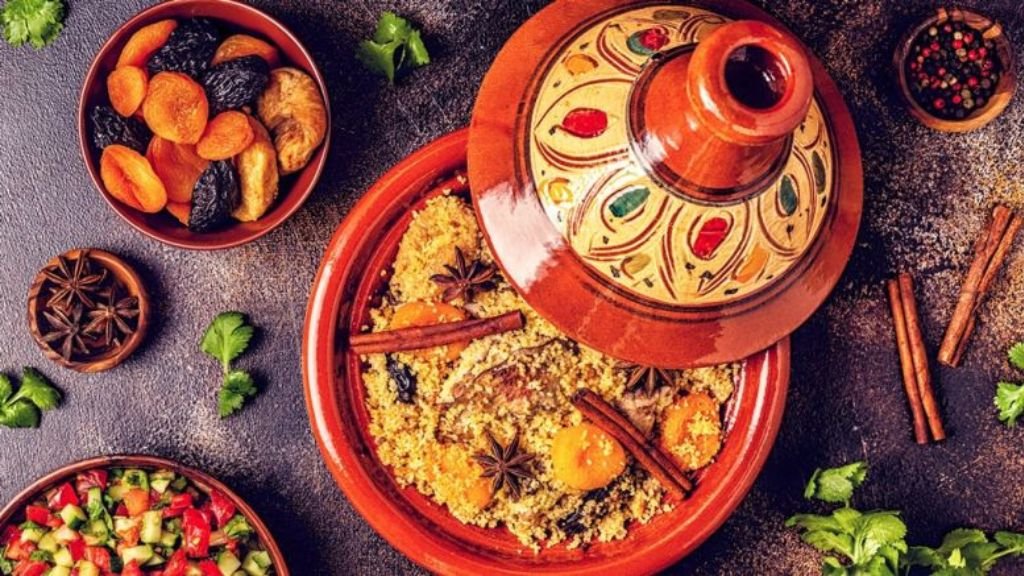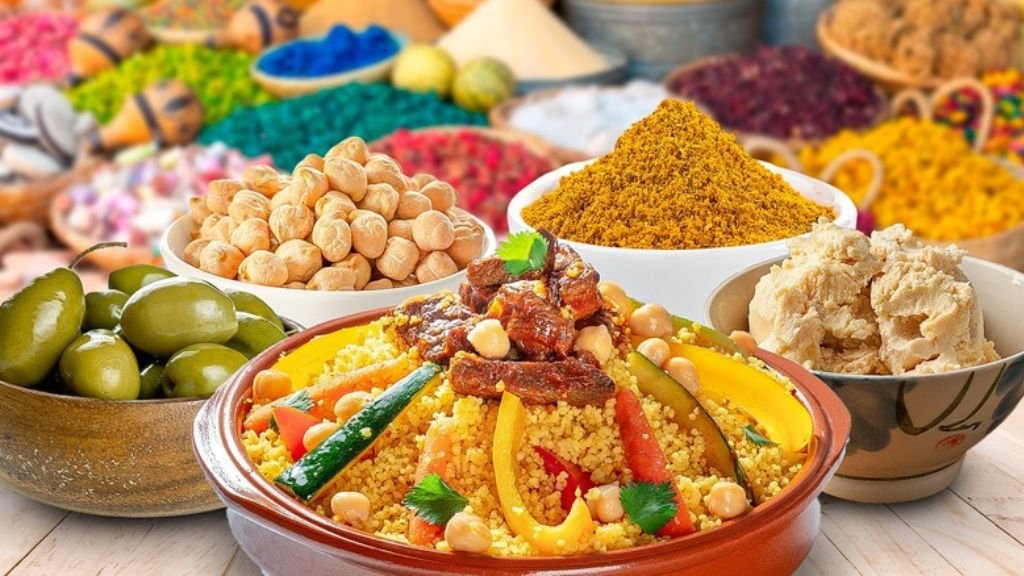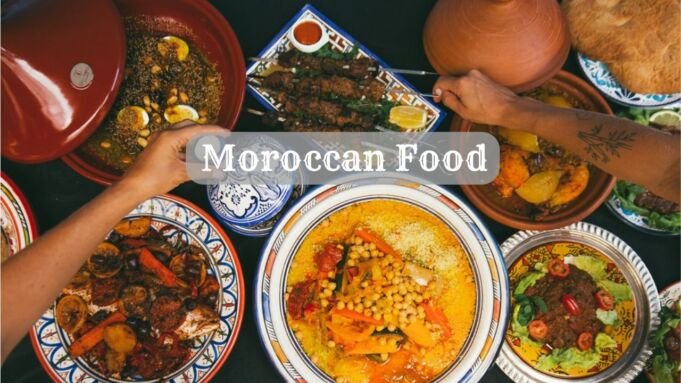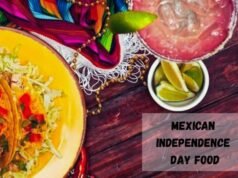Moroccan Food is a vibrant reflection of the country’s rich cultural tapestry, influenced by Berber, Arab, Andalusian, and French traditions. Known for its bold flavors and aromatic spices, Moroccan cooking offers a culinary adventure that revolves around communal and celebratory dining experiences.
Food plays a crucial role in human culture, with different regions and cultures around the world celebrated for their unique culinary offerings. If you’re planning a trip to Morocco, it would be a real loss to overlook the exceptional and delectable dishes that this magnificent country has to offer. Moroccan cuisine is globally recognized as among the finest, and you certainly wouldn’t want to miss the opportunity to experience this remarkable culinary delight.
Historical and Cultural Influences
Moroccan food is deeply rooted in the nation’s history, where each wave of conquerors and migrants left their mark on the cuisine. Spices like saffron and cinnamon arrived via ancient trade routes, enriching the local pantry with flavors that define Moroccan dishes today. These ingredients not only add depth and flavor but also signify Morocco’s important role in the spice trade.
Staple Ingredients in Moroccan Cooking
Essential to Moroccan dishes are ingredients like lamb, chicken, and seafood, which are often accompanied by vegetables and the ubiquitous couscous. Spices play a pivotal role, with cumin, coriander, saffron, and the special blend known as ras el hanout adding distinctive flavors that make Moroccan cuisine uniquely appealing.
Related: Turkish Foods
25 Moroccan Foods You Must Try In Morocco

Morocco is renowned for its rich culinary heritage, combining Arab, Berber, and French influences into a vibrant gastronomic experience. Here are 25 Moroccan foods that you absolutely must try when visiting Morocco:
1. Tagine
Tagine is the quintessential Moroccan dish, named after the conical clay pot it’s cooked in. This slow-cooked stew can include a variety of ingredients such as lamb, chicken, or fish alongside vegetables, fruits, and a rich blend of spices, creating a tender and aromatic meal.
2. Couscous
Often considered the national dish of Morocco, couscous is steamed balls of semolina usually served with a stew spooned over it. It’s traditionally eaten on Fridays in Morocco and comes in different variations including vegetable, beef, and lamb.
3. Harira
This hearty soup is traditionally consumed during Ramadan to break the fast but is enjoyed year-round. Made with tomatoes, lentils, chickpeas, and lamb, it’s seasoned with a medley of herbs and spices, making it a flavorful and filling dish.
READ: Lebanese Food
4. B’stilla (Pastilla)
This unique pie combines sweet and savory flavors, typically featuring a filling of pigeon meat (although chicken is a popular substitute), almonds, and eggs, wrapped in a crispy, thin pastry and topped with powdered sugar and cinnamon.
5. Mechoui
Mechoui refers to the slow-roasted lamb that’s usually cooked whole over an open fire or in a special oven, resulting in tender, fall-off-the-bone meat that’s often served with cumin and salt.
6. Kefta Tagine
Kefta refers to meatballs made from spiced ground meat—usually lamb or beef—mixed with herbs and onions. In a kefta tagine, these meatballs are cooked in a tomato and onion sauce, often topped with eggs.
7. Zaalouk
Zaalouk is a smoky eggplant and tomato salad, seasoned with garlic, paprika, cumin, and fresh herbs. It’s usually served as a side dish or dip and is a staple at Moroccan mealtimes.
8. Rfissa
This traditional dish is served during special occasions and consists of shredded pieces of msemen (Moroccan pancakes) or bread, topped with chicken, lentils, and fenugreek seeds, all stewed with saffron, ras el hanout, and other spices.
9. Mrouzia
Mrouzia is a sweet and savory tagine that features lamb, prunes, almonds, and a blend of Moroccan spices, including ras el hanout. It’s typically prepared during the festival of Eid al-Adha but enjoyed at other times as well.
READ: Venezuelan Food
10. Fish Chermoula
Chermoula is a marinade used in Moroccan cooking, which is made from herbs, oil, lemon juice, pickled lemons, garlic, cumin, and salt. Fish chermoula involves marinating fish in these spices before grilling or baking.
11. Moroccan Mint Tea
Known as “Moroccan whiskey,” mint tea is the drink of hospitality, made with green tea, mint leaves, and a significant amount of sugar, served hot.
12. Sfenj
A traditional Moroccan doughnut, sfenj is made from unsweetened, sticky dough (akin to a yeast dough), deep-fried until puffy and golden, then dipped in honey or sprinkled with sugar.
13. Moroccan Salad Plate
A common start to meals consists of several small salads served on one plate, including carrot salad, cucumber salad, beet salad, potato salad, and more, each flavored distinctively.
14. Makouda
Makouda are small, deep-fried potato balls, often spiced with cumin and garlic. They’re typically served with spicy harissa sauce as a snack or a sandwich filler.
READ: Nigerian Food
15. Lemon Chicken Tagine
This popular tagine dish combines chicken with tart-preserved lemons and olives, embodying the unique flavors of Moroccan cuisine with a rich, citrus-infused sauce.
16. Stuffed Sardines
This dish features sardines stuffed with a spicy chermoula paste, breadcrumbs, and herbs, then fried or grilled to perfection—a popular choice in coastal regions.
17. Brochettes (Moroccan Skewers)
Brochettes are Moroccan skewers made with marinated meat (commonly lamb or beef), grilled on open flames, and served with a variety of dips.
18. Harcha
Harcha is a Moroccan flatbread made from semolina, butter, and milk, pan-fried to create a crispy exterior with a soft, warm interior, often served with honey or jam.
19. Lamb or Beef with Prunes Tagine
This dish represents the sweet and savory combination typical of Moroccan cuisine, featuring tender meat slow-cooked with prunes, almonds, and a blend of spices.
20. Baghrir
Known as Moroccan pancakes, baghrir are spongy and characterized by their unique “thousand holes” that appear as they cook. They’re usually enjoyed with honey and butter.
21. Moroccan Carrot Salad
This refreshing salad consists of grated or sliced carrots seasoned with garlic, cumin, paprika, and lemon juice, offering a zesty, light side dish.
Read Also: AirFood Recipes
22. Moroccan Orange Salad
A sweet, refreshing dessert or side dish, this salad combines sliced oranges with cinnamon and orange blossom water, often garnished with mint leaves.
23. Baklava
Though not originally from Morocco, baklava has found a home in Moroccan pastry shops, featuring layers of filo pastry filled with nuts and soaked in honey.
24. Seffa Medfouna
Seffa medfouna is a celebratory dish, usually made with steamed vermicelli or couscous, butter, sugar, and sometimes cinnamon, served with meat or chicken hidden beneath the pasta.
25. Loubia
Loubia is a comforting bean stew made from white beans cooked in a flavorful tomato sauce with garlic, herbs, and Moroccan spices, often enjoyed as a hearty meal in colder months.
These dishes showcase the rich culinary landscape of Morocco, offering a taste of its diverse flavors and cooking traditions that have been refined over centuries. Whether you’re dining in a lavish Moroccan palace or a bustling street market, the flavors of Morocco are sure to leave a lasting impression.
READ: Armenian Food
Traditional Moroccan Dishes

Moroccan Food is deeply rooted in the traditional Berber diet, which primarily consists of lamb, vegetables, and dairy, enhanced by a subtle blend of spices such as cumin, turmeric, paprika, and cayenne, along with fragrant herbs like mint, coriander, and parsley.
Drawing on Southern European influences, Moroccan recipes frequently incorporate olives, olive oil, and tomatoes, enriching the overall flavor profile.
Due to the predominance of meat (excluding pork due to Islamic dietary laws), vegetarian options can sometimes be limited within Moroccan cuisine.
- Tagine: Perhaps the most iconic Moroccan dish, tagine refers to both the conical clay cooking pot and the stew cooked within it. Ingredients simmer slowly together, creating tender meats and flavorful sauces, often enhanced with dried fruits and nuts.
- Couscous: Served traditionally on Fridays, this steamed dish of semolina grains is typically topped with a stew of meat and vegetables, symbolizing the heart of Moroccan home cooking.
- Pastilla: Originally from Fez, pastilla is a savory pastry that wraps pigeon or chicken, almonds, and eggs in a crispy, flaky dough, dusted with cinnamon and sugar for a sweet and savory finish.
- Harira: This hearty soup is essential during Ramadan, made from tomatoes, lentils, chickpeas, and lamb, seasoned with a medley of spices and often served with a lemon wedge and dates.
Street Food and Snacks
- Sfenj: These airy, ring-shaped doughnuts made from unsweetened yeast dough are a portion of beloved street food, typically enjoyed in the morning dipped in honey or sugar.
- Briouats: These small triangles of phyllo dough are stuffed with meat, cheese, or seafood, and fried to golden perfection, representing a staple at Moroccan celebrations and gatherings.
- Makouda: These small potato fritters are a popular snack, often served in a sandwich or with a spicy harissa sauce.
Read Also: Filipino Food
Moroccan Desserts and Sweets
Moroccan desserts often feature fruits like dates, figs, and apricots, alongside pastries such as baklava and the traditional cookies known as riba. Desserts are typically served with mint tea, complementing the sweet finish with refreshing flavors.
Beverages
- Mint Tea: More than just a drink, mint tea is a sign of hospitality, friendship, and tradition, served throughout the day in almost every Moroccan home and shop.
- Coffee: While not as central as tea, coffee is still enjoyed widely, often as a social drink in cafes and after meals.
Eating Out in Morocco
Dining out in Morocco offers a chance to experience the country’s hospitality in traditional settings like riads or bustling street markets. Visitors should try local delicacies such as snail soup and grilled sardines, adhering to local dining etiquette to fully embrace the communal dining experience.
Moroccan Food Abroad
Globally, Moroccan Food has been embraced for its unique flavors and cooking techniques. Overseas, dishes like tagine and couscous have been adapted to local tastes and available ingredients, showcasing the cuisine’s versatility and worldwide appeal.
What is Morocco Ranked in Food?
Morocco is frequently celebrated for its culinary heritage, which is rich in flavors and steeped in a long history of cultural influences. While specific global rankings can vary by source and criteria, Moroccan cuisine is often ranked highly for its distinctive use of spices, diverse ingredients, and unique cooking techniques that have evolved over centuries.
Dishes like tagine, couscous, and pastilla showcase the intricate blend of flavors that characterize Moroccan cooking, making it a favorite among food enthusiasts worldwide. The global appreciation of Moroccan cuisine is a testament to its ability to meld flavors from its Arab, Berber, Moorish, and French influences into dishes that are both flavorful and deeply comforting.
What Religion is in Morocco?
Morocco is predominantly a Muslim country, with Islam being the state religion and deeply integrated into the culture and daily life of its people. The vast majority of Moroccans adhere to Sunni Islam, particularly of the Maliki school of jurisprudence. Islam first arrived in Morocco in the 7th century with Arab conquests and has since shaped the nation’s identity, influencing its architecture, traditions, laws, and social norms.
The Moroccan constitution guarantees freedom of religion and allows for the practice of other faiths; however, the presence of other religions is relatively small, with Jewish and Christian communities comprising a minor percentage of the population. The king of Morocco holds a special title, “Commander of the Faithful,” emphasizing his role as a spiritual leader in addition to his political authority, further underscoring the significant role of Islam in Moroccan society.
To Know More: Honduran Food
Do They Speak English in Morocco?
In Morocco, the primary languages are Arabic and Berber, with Arabic being the official language and Berber also holding official status. French is widely spoken and serves as the primary language for business, government, and diplomacy. While English is not as commonly used as French, its presence is steadily growing, especially in the major cities and among the younger population.
In tourist areas, English is more commonly spoken, and many Moroccans involved in tourism will likely have a good grasp of English to communicate effectively with international visitors. Therefore, while not ubiquitous, English-speaking travelers will generally find it possible to communicate in English, particularly in hotels, major restaurants, and tourist sites.
Conclusion
Moroccan Food is an exploration of flavors and traditions that reflect the country’s historical richness and cultural diversity. Whether dining in a lavish Moroccan palace or cooking a simple tagine at home, the aromas and tastes of Moroccan dishes promise a culinary journey that is both exotic and profoundly satisfying.
Frequently Asked Questions (FAQs) about Moroccan Food
Here are seven frequently asked questions about Moroccan food that delve into its diverse flavors and key characteristics:
What are the most essential spices used in Moroccan cooking?
Moroccan cuisine is well-known for its use of rich and vibrant spices. Cumin, coriander, saffron, and cinnamon are staples in many dishes, along with the distinctive spice blend known as ras el hanout, which includes a mixture of up to 30 spices.
What is a traditional Moroccan breakfast like?
A typical Moroccan breakfast often includes breads like khobz or baghrir, served with honey, jam, and cheese. Olives, along with fresh or stewed fruits, and mint tea are also common. In some regions, a semolina soup known as harira might be served.
Are there vegetarian options in Moroccan cuisine?
Yes, Moroccan cuisine offers a variety of vegetarian dishes. Vegetable tagines, couscous with vegetables, and salads like zaalouk (eggplant dip) and taktouka (bell pepper salad) are popular. Dishes such as bissara, a fava bean soup, are also common vegetarian options.
What are typical Moroccan desserts?
Moroccan desserts often feature fruits, nuts, and spices. Common sweets include pastries like baklava, cornes de gazelle (crescent-shaped almond pastries), and briouats (almond-stuffed pastries). Desserts are often seasoned with cinnamon or orange flower water and served with mint tea.
How is Moroccan tea prepared and served?
Moroccan mint tea, a symbol of hospitality, is prepared with green tea, fresh mint leaves, and a generous amount of sugar. It is traditionally brewed in a teapot and poured from a height to create foam, served in small glasses rather than cups.
What is the significance of tagine in Moroccan cuisine?
The tagine is both a cooking vessel and the name of the dish prepared in it. This earthenware pot with a conical lid allows slow simmering, which tenderizes the meat and enhances the spices and flavors in the dish. Tagines can include a variety of ingredients such as meats, poultry, fish, vegetables, and fruits, making them a centerpiece in Moroccan meals.
Can I find Moroccan food that is suitable for gluten-free diets?
Many Moroccan dishes are naturally gluten-free, especially those based on rice, meats, vegetables, and legumes. Dishes like tagine and grilled meats are safe options. However, it’s advisable to avoid dishes involving breads or pastries unless specifically made from non-wheat flour.
















[…] soup. These experiences not only tantalize your taste buds but also offer a deeper appreciation of Morocco’s culinary […]
Comments are closed.